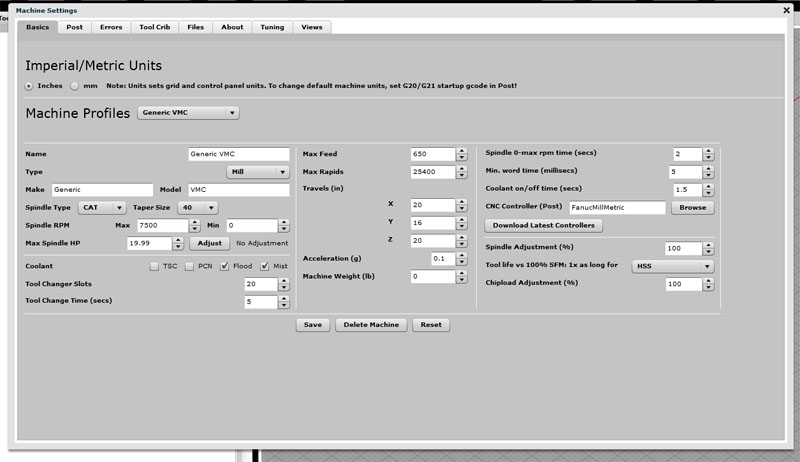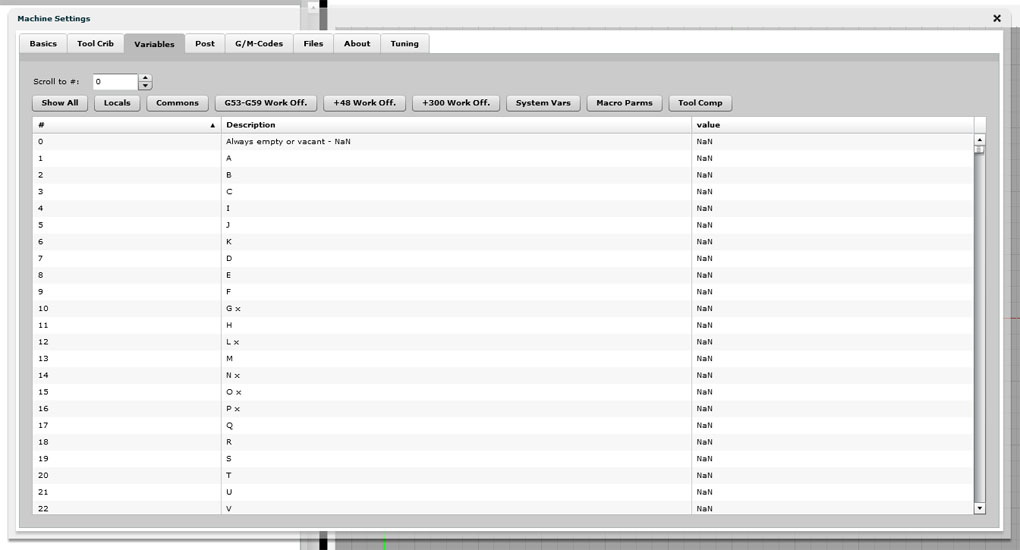GW Editor User Guide
|
||||||||
|
G-Wizard Editor: Setup Video Overview of Setup
The G-Wizard Editor Setup Tool... Introduction to Setup The GWE Setup Tool is accessed from the button on the far right, or from the Tools Setup menu choice. It contains a variety of sub-tools accessed by a tab bar along the top:
The Setup Tool... If you do nothing else with the Setup application, be sure to get your Imperial/Metric Units set, a Machine Profile Configured, and download a pre-defined CNC Controller. To access a controller, first click "Download Latest Controllers". This brings all the controller files (they're like Posts on a CAM program) onto your machine. Then you can use the "Browse" button next to the CNC Controller field on the Machine Profile to select one. The Setup tabs include:
We'll go into a little more depth on each one that's specific or different in GWE below. For Basics, Tool Crib, and Files, refer to G-Wizard Calculator Setup. From a g-code perspective, be aware that the default for GWE is Mach3, which is very close to Fanuc in most ways. You will want to go through the various settings and change them to match the way your controller operates. Basics The Basics tab is all about setting the units, as well as selecting and defining machine profiles. Let's talk units first. When you change the units, it changes the units for the controls in the editor and it changes the grid but it does not change how the simulator interprets coordinate values in g-code. To change the coordinate value units, use G20 (inches) or G21 (mm). You can either use these in your program, or you can use them in the Setup G-Code under the post tab. So, for example, if your CNC comes up by default expecting mm, put a G21 in your startup g-code. Always remember, G20 and G21 don't do unit conversion, they merely change how the numbers are interpreted. With G20, X0Y1 refers to X = 0 inches and Y = 1 inch. After a G21, X0Y1 refers to X = 0 mm and Y = 1 mm. When we say it changes the units for the controls in the editor, that means it changes the units for the XYZ coordinate display down on the status bar, for the Info tab, for the Simulator information that appears below the backplot, and so on. You can download a pre-defined CNC Controller configuration from CNCCookbook to save the effort of defining all the Post parameters. To access a controller, first click "Download Latest Controllers". This brings all the controller files (they're like Posts on a CAM program) onto your machine. Then you can use the "Browse" button next to the CNC Controller field on the Machine Profile to select one. GWE will automatically download the latest posts the first time you start up each new release. But, it won't update the post that you are actually using, because that would overwrite any changes you may have made. So, if you want to take advantage of newly downloaded posts, you'll have to Browse and select them manually. For more on machine profiles, check out the G-Wizard Calculator Setup documentation. Post See our Custom Posts page to learn how to customize our existing posts. Variables The Variables tab lets you access the internal variables of your simulated CNC machine. These are variables accessible via programs using a "#" and a number and are primarily of interest to programmers writing macros (sometimes called "Parameterized Programming"). But even if you're not writing macros, you may need to access them to set up your work offsets or other offsets so that your g-code program will run properly. Here is the Variables Tab:
The Variables Tab... As you can see, the Variables Tab consists of a scrolling list of all the variables together with a set of controls at the top to help you quickly find the variable you're looking for. If you know its number, you can type that into the "Scroll to #" box and get there immediately. If you only know the general category of the variable, you can filter the list using the following buttons:
Note: At the moment, there's not much you can customize on the Variables Tab. What to read next Next stop is the Commands page, where you'll learn what the menu choices do. If you're intent on creating a custom post for your machine, you may also want to check out our Custom Post page.
|
||||||||
|
|
|
|
|
|
|
||
|
|
|
|||||||




